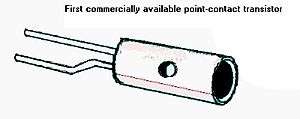Point-contact transistor
A point-contact transistor was the first type of solid-state electronic transistor ever constructed. It was developed by research scientists John Bardeen and Walter Brattain at Bell Laboratories in December, 1947.[1] They worked in a group led by physicist William Shockley. The group had been working together on experiments and theories of electric field effects in solid state materials, with the aim of replacing vacuum tubes with a smaller, less power-consuming device.
The critical experiment, carried out on December 16, 1947, consisted of a block of germanium, a semiconductor, with two very closely spaced gold contacts held against it by a spring. Brattain attached a small strip of gold foil over the point of a plastic triangle — a configuration which is essentially a point-contact diode. He then carefully sliced through the gold at the tip of the triangle. This produced two electrically isolated gold contacts very close to each other.

The piece of germanium used had a surface layer with an excess of electrons. When an electric signal traveled in through the gold foil, it injected holes (points which lack electrons). This created a thin layer which had a scarcity of electrons.
A small positive current applied to one of the two contacts had an influence on the current which flowed between the other contact and the base upon which the block of germanium was mounted. In fact, a small change in the first contact current caused a greater change in the second contact current, thus it was an amplifier. The first contact is the "emitter" and the second contact is the "collector". The low-current input terminal into the point-contact transistor is the emitter, while the output high current terminals are the base and collector. This differs from the later type of bipolar junction transistor invented in 1951 that operates as transistors still do, with the low current input terminal as the base and the two high current output terminals are the emitter and collector.
Unlike later semiconductor devices, it was possible for an amateur to make a point-contact transistor, starting with a germanium point-contact diode as a source of material (even a burnt-out diode could be used; and the transistor could be re-formed if damaged, several times if necessary).[2]
The point-contact transistor was commercialized and sold by Western Electric and others but was soon superseded by the bipolar junction transistor, which was easier to manufacture and more rugged. Germanium was employed extensively for two decades in the manufacture of transistors, but was then almost totally replaced by silicon and other alloyed materials. As of 2012 germanium point-contact diodes continued to be available for use as radio-frequency detectors.[3] Point-contact diodes are made of other materials, including silicon, and have good microwave properties.[4] Research continued as of 2012.[5]
Forming

To make a point-contact transistor work, a brief high-current pulse was used to fuse the wires to the germanium and create the P-type material around the point of contact, a technique called 'electrical forming'. Usually this was done by charging a capacitor of a specified value to a specified voltage then discharging it between the emitter and the base electrodes. Forming had a significant failure rate, so many commercial encapsulated transistors had to be discarded; an uncased device as could be made by amateurs could be re-formed if damaged.[2]
Characteristics
Some characteristics of point-contact transistors differ from the later junction transistor:
- The common base current gain (or α) of a point-contact transistor is around 2 to 3, whereas α of bipolar junction transistor (BJT) cannot exceed 1 and the common emitter current gain (or β) of a BJT is typically between 20 and 200.
- Differential negative resistance.
- When used in the saturated mode in digital logic, they latch in the on-state, making it necessary to remove power for a short time in each machine cycle to return them to the off-state.
See also
References
- ↑ Levine, Alaina G. "John Bardeen, William Shockley, Walter Brattain—Invention of the Transistor", 2008, American Physical Society Retrieved on October 6, 2010
- 1 2 HOME-MADE TRANSISTORS: P B Helsdon, Wirless World, January 1954. Article starts "It is quite practicable to make point-contact transistors at home which compare quite well with those advertised by professional manufacturers."
- ↑ NTE manufacture point-contact germanium diodes 1N34 and NTE110MP (matched pair)
- ↑ MBT Microwave/RF Semiconductors product Guide, listing several silicon microwave point-contact diodes. Accessed 23 April 2012
- ↑ Voltage sensitivity of a point-contact GaAs/AlGaAs heterojunction microwave detector, A Suˇzied˙elis, S Aˇsmontas, J Kundrotas, V Nargelien˙e and J Gradauskas, Phys. Scr.85(2012) 035702 (5pp). Example of ongoing research into point-contact devices.